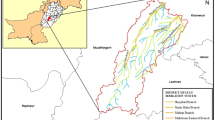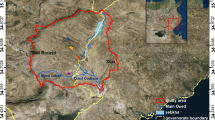Abstract
The timely precise information of land use land cover (LULC) in the canal command area can help in managing irrigation water according to the crop water requirement. A study was conducted to map the LULC of irrigated command area of three distributaries in the lower Chenab canal system, Pakistan, namely Mungi, Killianwala and Khurrianwala for the estimation of canal water deficit (CWD). Multispectral images of LANDSAT-7 were used for Rabi season of 2009–2010 and 2010–2011. Normalized difference vegetation index-based unsupervised classification was performed for the formation of LULC of the commands area. During the initial classification, totally nine clusters were created with maximum likelihood. These clusters were then merged into final four classes on the basis of field knowledge. Accuracy assessment was performed using error matrix; producer and user accuracies were estimated for each class with overall accuracy of 84% and 86% for the Rabi season 2009–2010 and 2010–2011, respectively. For the assessment of the irrigation water demand, potential evapotranspiration was estimated using the Penman–Monteith equation. Crop water requirement was estimated based on the 10-day Kc value of the mapped crop from the LULC. Irrigation water demand for cropped area was estimated from the LULC and crop evapotranspiration. Canal water deficit was estimated from the available canal water supply and irrigation water requirement in the Rabi season. During the Rabi seasons, average CWD was 64%, 72% and 32% (2009–2010) and 33%, 46% and 36% (2010–2011) for Khurrianwala, Killianwala and Mungi distributary, respectively.










Similar content being viewed by others
References
Agcaoili, M., & Rosegrant, M. W. (1995). Global and regional food supply, demand, and trade prospects to 2010. In Population and food in the early twenty-first century: Meeting future food demand of an increasing population.
Ahmad, I., Saeed, U., Fahad, M., Ullah, A., ur Rahman, M., Ahmad, A., et al. (2018). Yield forecasting of spring maize using remote sensing and crop modeling in Faisalabad-Punjab Pakistan. Journal of the Indian Society of Remote Sensing, 46(10), 1701–1711. https://doi.org/10.1007/s12524-018-0825-8.
Ahmad, I., Wajid, S. A., Ahmad, A., Cheema, M. J. M., & Judge, J. (2019). Optimizing irrigation and nitrogen requirements for maize through empirical modeling in semi-arid environment. Environmental Science and Pollution Research, 26(2), 1227–1237. https://doi.org/10.1007/s11356-018-2772-x.
Alganci, U., Sertel, E., Ozdogan, M., Ormeci, C., Sertel, E., Ormeci, C., et al. (2015). Determination of spatial water requirements at county and regional levels using crop models and GIS—An example for the State of Parana, Brazil. Agricultural and Forest Meteorology, 8(3), 113–129. https://doi.org/10.1080/014311602320567955.
Allen, R. G., Pereira, L. S., Raes, D., & Smith, M. (1998). Crop evapotranspiration-Guidelines for computing crop water requirements-FAO Irrigation and drainage paper 56. FAO, Rome, 300(9), D05109.
Awan, U. K., Anwar, A., Ahmad, W., & Hafeez, M. (2016). A methodology to estimate equity of canal water and groundwater use at different spatial and temporal scales: a geo-informatics approach. Environmental Earth Sciences, 75(5), 409.
Barker, R. (2004). Evolution of irrigation in South and Southeast Asia (Vol. 5). Colombo: Iwmi.
Bhatti, A. M., Suttinon, P., & Nasu, S. (2009). Agriculture water demand management in Pakistan: a review and perspective. Society for Social Management Systems, 9(172), 1–7.
Cheema, M. J. M., & Bastiaanssen, W. G. M. (2012). Local calibration of remotely sensed rainfall from the TRMM satellite for different periods and spatial scales in the Indus Basin. International Journal of Remote Sensing, 33(8), 2603–2627.
Di Gregorio, A. (2005). Land cover classification system: classification concepts and user manual: LCCS (Vol. 8). Rome: Food & Agriculture Org.
Dong, Y., Forster, B., & Ticehurst, C. (1997). Radar backscatter analysis for urban environments. International Journal of Remote Sensing, 18(6), 1351–1364.
Giri, C., & Jenkins, C. (2005). Land cover mapping of Greater Mesoamerica using MODIS data. Canadian Journal of Remote Sensing, 31(4), 274–282.
Govt. of Pakistan. (2004). Pakistan Economic Survey 2004-2005. Ministry of Food and Agriculture, Federal Bureau of Statistics. Govt. of Pakistan, Islamabad. Pakistan
Hardee, K., & Leahy, E. (2008). Population, fertility and family planning in Pakistan: a program in stagnation. Population Action International, 3(3), 1–12.
Homer, C. D., & Pratt, P. F. (1961). Methods of analysis for soils, plants and waters. University of California. Berkeley: Agr. Sci. Publications.
Iwmi, I. (2000). World Water Supply and Demand: 1995 to 2025. Colombo, Sri Lanka. Colombo: International Water Management Institute.
Jehangir, W. A., Qureshi, A. S., & Ali, N. (2002). Conjunctive water management in the Rechna Doab: An overview of resources and issues (Vol. 48). Colombo: IWMI.
Kachhwaha, T. S. (1986). Temporal monitoring of forest land for change detection and forest cover mapping through satellite remote sensing techniques. In Asian conference on remote sensing, 6th, Hyderabad, India (pp. 276–281).
Lobell, D. B. (2013). The use of satellite data for crop yield gap analysis. Field Crops Research, 143, 56–64. https://doi.org/10.1016/j.fcr.2012.08.008.
Monheit, A. C. (2011). Running on empty. Journal of Medical Care Organization, Provision and Financing, 48, 177–182.
PBS. (2010). Punjab Development Statistics, Punjab Bureau of Statistics Government of the Punjab Lahore.
Thenkabail, P., Lyon, J. G., Turral, H., & Biradar, C. (2010). Remote sensing of global croplands for food security. Boca Raton: CRC Press.
Ullah, M. K., Habib, Z., & Muhammad, S. (2001). Spatial distribution of reference and potential evapotranspiration across the Indus Basin Irrigation Systems (Vol. 24). IWMI.
UNDP. (2002). Sustainable Human Development. Governance for Sustainable Human Development. A UNDP Policy Document.
Venturini, V., Islam, S., & Rodriguez, L. (2008). Estimation of evaporative fraction and evapotranspiration from MODIS products using a complementary based model. Remote Sensing of Environment, 112(1), 132–141.
WAPDA. (1979). Revised action plan for irrigated agriculture. Main Report, Vol. 1. Master Planning and Review Division.
WAPDA. (2011). Hydro potential in Pakistan, Pakistan water and power development authority. www.wapda.gov.pk.
Wessels, K. J., De Fries, R. S., Dempewolf, J., Anderson, L. O., Hansen, A. J., Powell, S. L., et al. (2004). Mapping regional land cover with MODIS data for biological conservation: Examples from the Greater Yellowstone Ecosystem, USA and Pará State, Brazil. Remote Sensing of Environment, 92(1), 67–83.
Wu, C., Munger, J. W., Niu, Z., & Kuang, D. (2010). Comparison of multiple models for estimating gross primary production using MODIS and eddy covariance data in Harvard Forest. Remote Sensing of Environment, 114(12), 2925–2939.
Acknowledgements
This research was accomplished in the Department of Irrigation and Drainage under DAAD-funded project led by Dr. Usman Khalid Awan, Dr. Bernhad Tichbian and Dr. Christopher Conard. We are also thankful to Water Management Research Centre affiliated with University of Agriculture, Faisalabad, for smooth running of the project.
Author information
Authors and Affiliations
Corresponding authors
Additional information
Publisher's Note
Springer Nature remains neutral with regard to jurisdictional claims in published maps and institutional affiliations.
About this article
Cite this article
Waqas, M.M., Awan, U.K., Cheema, M.J.M. et al. Estimation of Canal Water Deficit Using Satellite Remote Sensing and GIS: A Case Study in Lower Chenab Canal System. J Indian Soc Remote Sens 47, 1153–1162 (2019). https://doi.org/10.1007/s12524-019-00977-9
Received:
Accepted:
Published:
Issue Date:
DOI: https://doi.org/10.1007/s12524-019-00977-9




